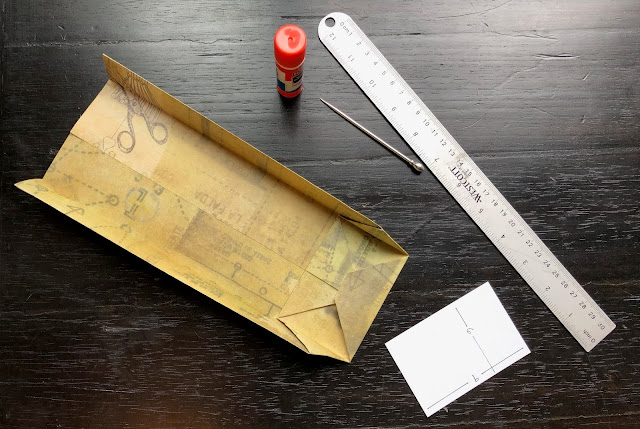The previous post was done in centimeters, and there's no use in stopping now. Assuming we would like each of the four corners of your envelope to cross the center point of the card by 1 centimeter, you will need:
1. Your card of dimensions L by W
2. A rectangular piece of paper of dimensions (L+1) by (W+1)
3. A larger rectangular piece of paper; (2L+2) by (2W+2) is plenty*
4. A ruler
5. A pencil
6. Paper cutting devices (paper cutter, scissors, craft knife, etc.)
7. Some form of adhesive (tape, glue stick, etc.)
Optional materials include:
1. Address labels
2. Postage stamps
3. Circular objects for rounded edge tracing
4. Decorative paper cutting devices (paper edge punchers, nail clippers, etc.)
5. Decorations (stickers, stamps, calligraphy, etc.)
Step 1:
Trace the diagonal on your (L+1) by (W+1) rectangle and cut along this line. This will be your measuring triangle. Label the smallest side A, the middle side B, and the hypotenuse C.
Step 2:
Arrange the larger piece of paper so that the pretty side is facing down. If one side is longer than the other, place that side going left to right and the shorter side going up and down. With your measuring triangle, align C to the bottom edge starting at the left corner, so that B is on the left and A is on the right. Lightly mark where the three angles touch the paper. We'll call this the starting position.
Step 3:
From the starting position, rotate the triangle about side A and mark angle BC on your paper.
From the starting position, rotate the triangle about side B and mark angle AC on your paper.
You now have 4 points that outline a rhombus with one point in the center.
Cut out your rhombus, taking care to ensure that your opposite sides are parallel.
Step 4:
Rotate your rhombus so that the corners are facing left, right, up and down. Place your card facing normally in the center of the rhombus and fold each corner of the rhombus around the card towards the center.
Step 5:
These folds will have made four small right triangles towards the midpoints of the edges of your rhombus. Cut and remove these triangles. You may widen the triangles, but take care not to cut further inwards than the 90° point. Trim the edges to your liking.
In the picture below, I have used nail clippers to round the edges, centered the card lower than the midpoint, trimmed the right flap, and traced a cup as a guide to round off the top. All of this is simply to say you've got options.
Step 6:
Seal the bottom flap over the two sides, finish decorating, insert your card, and seal your envelope. I like to use upwards facing tape to seal my envelopes.
by (2)(L+1)(W+1)/(√[(L+1)²+(W+1)²]).
If you can tell me how those are derived, I'll mail you a congratulatory card in a handmade envelope with a beautiful stamp. That last part is easy, for I only buy beautiful stamps.
PS. A limiting factor for making your own envelopes is the idea that time is precious and envelopes aren't. Fear not. After your first envelope, you could try making your next without a measuring triangle by using your ruler and your card to mark rhombus points. (And since you're an expert, if you'd like your envelope to overlap more in one direction than the other, you could adjust your measuring triangle or your imaginary measuring triangle accordingly.) By skipping the measuring triangle and the trim steps, you could have a customized envelope on your hands in less than a minute. Additionally, if you have several cards of the same size, you could keep one good rhombus template for them all. Give it a try!






























